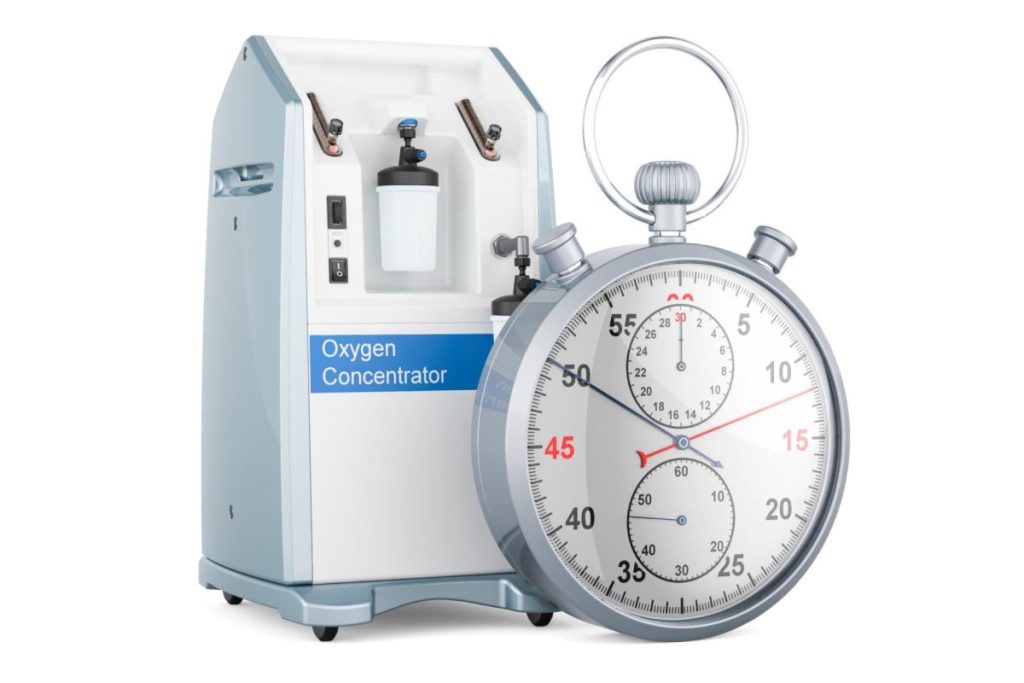Table of Contents
What is an Oxygen Concentrator or Extractor?
Oxygen Concentrator – Air contains 78% nitrogen and only 21% oxygen. The oxygen concentrator or extractor filters the ambient air through the pores of a molecular sieve that retains nitrogen molecules and allows oxygen molecules to pass through. The air thus clean contains 90% pure oxygen for a flow rate of 2.5 liters per minute.
Composition of Oxygen Concentrators
Oxygen concentrators provide oxygen flow ranging. The sucked air is first filtered to rid it of impurities (dust, etc.), then passes under high pressure into a cylinder filled with zeolite, which fixes the nitrogen and allows oxygen to pass.
The Two Cylinders Work Cyclically
One works while the other cleans. Oxygenated air can be humidified by passing it through a container of sterile water before the user inhales it through goggles or an oxygen mask. The classic models used at home are small “furniture” on wheels weighing 14 to 25 kg that operate on the mains (220V).
The lighter, battery-powered models allow for a few hours of independent trips outside the home. Transportable models (on a trolley) weigh 8 to 10 kg, and portable models (in a shoulder bag) weigh 2 to 4 kg. Their weight often tied to the number of batteries they have and, therefore, their ability to be autonomous.
What is an Oxygen Concentrator or Extractor Used For?
Oxygen therapy prescribes in the long term in the context of chronic respiratory pathologies:
chronic obstructive pulmonary disease (COPD)
cystic fibrosis
high blood pressure from disturbances in the arteries of the lungs;
sleep apnea
or for the short-term (less than three months) treatment of respiratory or ENT diseases
It is prescribed in palliative care or in the event of end-of-life dyspnea.
oxygen flow
The oxygen flow adjusts according to the patient’s clinical parameters and lifestyle. Two values are set:
Oxygen flows during exercise (6-minute walk or exercise test determined by); flow at rest. The flow of oxygen is delivered either continuously or by pulse. In this case, there is no “waste” of oxygen, which further reduces the size of the concentrator.
The second interest is that the patient should try to inhale rather than remain passive. In the case of nap apnea, the flow is continuous, as breathing is less deep during sleep, so there is less oxygen supply.
Indication
Long- Term Oxygen Therapy Prescribe:
In case of another chronic respiratory insufficiency. When Pa02< 60mmHgl, particular ambulatory oxygen therapy prescribe: Oxygen deficiency in exercised people define by Pa02 < 60mmHg or at least a 5% reduction in Spo2 oxygen saturation. Therefore the use of a concentrator is necessary only during attempts.
How is an Oxygen Concentrator or Extractor Used?
Operation Phase
- Plug in the concentrator and turn it on: an audible alert sounds for a few seconds;
- Wait for 5 to 10 min for the oxygen level to reach 100%
- Adjust the flow meter until the ball is stable at the specified level. not be
- If essential, connect the oxygen outlet to the humidifier. do
- Ther connect the tubing to the concentrator on one side and the glasses or mask on the other
- Check that oxygen is coming from the tubing
- Put on the goggles or mask and breathe
- at the end of the session
- turn off the device.
Security
The sum of oxygen delivered to the patient is continuously monitored. In the event of a power failure, an alarm and a battery trigger. In case of excess current, the circuit automatically.
Dust off the concentrator, including the inlets, at least once a week;
Change the aquatic in the humidifier every day, clean it with soapy water, and rinse it off with white vinegar regularly.
Change glasses or oxygen mask every two calendar week
Clean the dirt filter after every 100 hours of use and replace it when worn out. Precautions to take Make sure there is clear space around the device for it to function correctly.
Do not cover it; Do not place it on carpet that is too soft (some devices have their ventilation system located below)
Oxygen is a flammable gas so take care to keep the concentrator away from all combustible materials (oils, grease, cigarettes, etc.) and to ventilate the room well; In terms of transportation, don’t put it down
How to Choose an Oxygen Concentrator or Extractor?
Different Models A suitable oxygen extractor must be reliable, robust, quiet, have an excellent cooling system and be easy to use.
There are various parameters to take into account: oxygen flow: Battery life for outdoor use,
Flow: continuous or pulsed; Usage: “sedentary” indoors or “mobile” outdoors.
Price: Some models are available for rent. The medical prescription should specify.
The flow of 02 litres per minute at rest, Mode of Administration: Pulsed or Continuous Duration of administration per day and several daily sessions.
Alternatives to oxygen concentrators are other types of oxygen sources for home oxygen therapy. If so, Not that they do not use air to produce oxygen. They present similar clinical interests.
That is, Cylinders of compressed gaseous oxygen: are typically used in breakdown or running. In addition to concentrators, liquid oxygen tanks can store a massive amount of oxygen in a minimal volume (1 litre of liquid oxygen Can supply 860 litres of gaseous oxygen). Unlike the extractor, these two models have the major disadvantage of being recharged regularly. Fear of leaks and running out of fuel are sources of stress.
Conclusion
In general, the oxygen concentrator is a device for medical use intended for people suffering from cardiorespiratory insufficiency with a hypoxemic component. These devices concentrate the dioxygen of the ambient air by eliminating the dinitrogen and can thus produce oxygen at nearly 90%.
